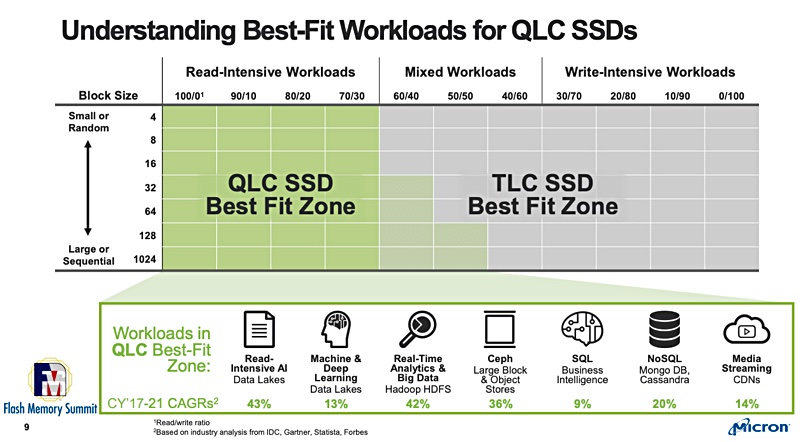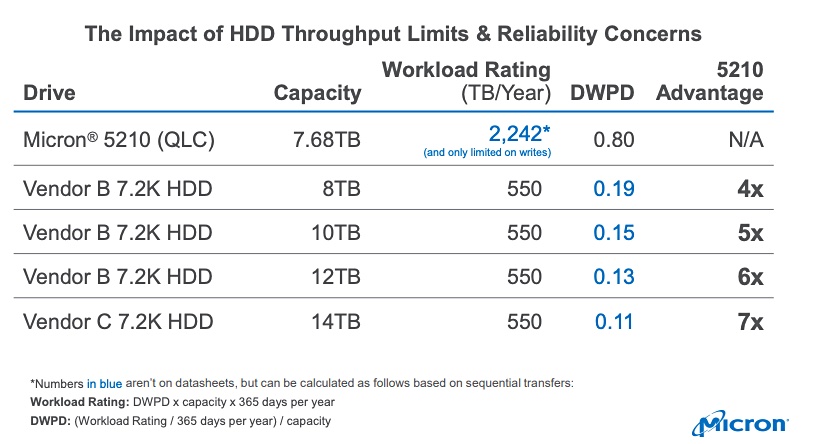QLC NAND memory is more reliable than HDDs and organisations that need storage for read-intensive applications should switch to these next generation SSDs. So says Micron.
Appropriate QLC flash workloads include processing data lakes, machine and deep learning, real-time analytics and Hadoop-style applications, plus Ceph, SQL and noSQL business intelligence and media streaming by content delivery networks, according to Micron.
Cloud services, vSAN capacity storage, and financial, regulatory and compliance storage could also get an QLC SSD boost, the computer memory maker said.
Micron notes these applications are read-intensive and require fast access. They do not require much over-writing which shortens the life of SSDs as their working life (endurance) is defined by the number of write cycles they support.
Micron’s interest here is that it has launched QLC (4bits/cell) SSDs which have a lower $/TB cost than current TLC (3bits/cell) drives – but a lower endurance. For SSDs this is measured in drive writes per day (DWPD). By contrast, for disk drives the number of terabytes written per year over the warranty period is quoted.
QLC SSD’s lower endurance means they are unsuitable for write-intensive workloads but they represent an alternative to disks for fast access read-intensive work. Kent Smith, a Micron SSD marketer, showed the best fit workload chart for its SSDs on this basis at the Flash Memory Summit 2019.

Smith also compared disk drives from two unnamed manufacturers and Micron’s 5210 ION QLC SSD. He devised a DWPD rating for disk drives from the two manufacturers to enable a like for like comparison between the two storage technologies. The disk DWPD calculation was simple; divide the TB/year number by 365. Here is the results table he presented:

Micron says its 5210 SSD has a DWPD rating of 0.8. That means it has a 4x to 7x advantage over the HDDs in the table above. For example, vendor C’s 14TB has a TB/year rating of 550, which means an 0.11 DWPD value. Since the 5210’s DWPD rating is 0.8 that is slightly more than a 7x advantage in favour of the 521
[N.B. Seagate’s 14TB Exos disk drive has a 550TB/year workload rating. Western Digital’s 8TB, 10TB and 12TB Gold disk drives also have a 550TB/year rating. We deduce that vendor B is Western Digital and vendor C is Seagate. These drives are warranted for five years.]
Why it matters
To show that this is important Micron quotes a Seagate disk drive datasheet; “Maximum rate of <550TB/YR (5-year warranty). Workloads exceeding the annualized rate may degrade the drive MTTF and impact reliability.”
That means HDD failure rates increase when HDDs hit their maximum workload rating – an HDD metric of total throughput. This applies to reads and writes whereas SSDs only wear when writing.
Counter arguments
Competing SSD manufacturer Samsung thinks that DWPD is no longer fit for purpose as a useful measure of SSD endurance. It argues that terabytes written (TBW) is a more appropriate way to measure endurance.
Samsung asserts that, as SSD capacities increase, DWPD requirements decrease. Content is rewritten fewer times on larger capacity SSDs and so it is inappropriate to use the same DWPD rating as lower capacity SSDs.
Blocks & Files thinks this is not relevant to Micron’s argument. The table above provides a 2,242TB/year workload rating for its SSD’s data writes, which is 4x higher than the disk drives. But the point Micron makes is that its SSD can specifically sustain more read work than the disk drives because their reliability deteriorates after the TB/year number is exceeded.
Consultant Hubbert Smith is not a fan of QLC SSDs, asserting that they are a whole new type of ugly, in a recent Blocks & Files column. Using QLC SSDs for cold storage is a bad idea, he said, but he excludes system vendors using these SSDs to drive to lower cost/GB for storage generally. ” In a system this is likely workable,” he writes.
Micron’s argument withstands comparison with Samsung’s and Smith’s views. In a nutshell, customers can read data in greater amounts and more frequently from the 5210 SSD than they can from HDDs, and at rates that exceed the disk drive’s warranted performance.
So, Micron wants us to understand – SSDs rule, OK! Eat your heart out, disk drive fans.








